Hanging laundry up to dry indoors often gives rise to unpleasant odors. These odors come from the metabolites of bacteria that eat the small amounts of sebum and protein grime remaining on clothing even after washing as well as grime oxidized in the air. To determine just what kind of odors people who hang their laundry indoors perceive at which phases of the laundry process, we conducted research using actual odorous clothing. Our results revealed that they often perceive “sour and sweaty,” “musty,” and “rank” odors when using laundry dried indoors, and that many of them find these odors very unpleasant. Furthermore, we found that, although those unpleasant odors are largely undetectable when laundered items have dried, they reemerge when items absorb moisture during use.
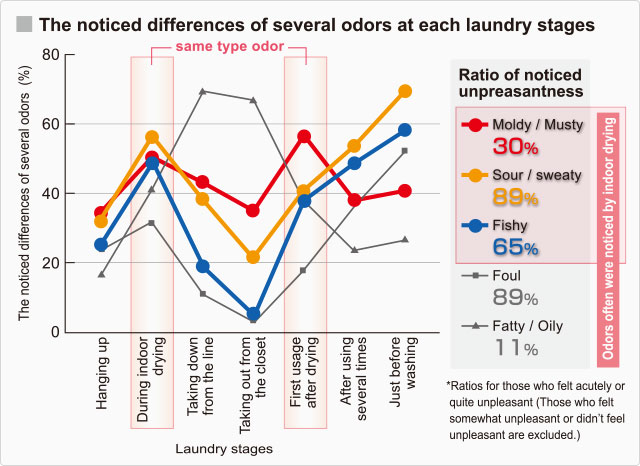
To identify the odorous substances, we moistened indoor-dried towels and analyzed the odorants using gas chromatography-mass spectrometry (GC-MS).
As a result, we found that the major sources of the “sour and sweaty” odor are medium-chain fatty acids, and that of the “rank” smell is an amine compound known as triethylamine. This was the first time that the occurrence of triethylamine on laundry had been confirmed. Furthermore, we also confirmed that the volatilization volume of these substances increased when the laundry was moistened.

Heyaboshi (Hang-to-Dry Indoors) TOP is blended with the anti-bacterial agent sodium alkanoyloxybenzenesulfonate (OBS). During washing, OBS reacts with sodium percarbonate to generate organic peroxy acid, which kills bacteria by breaking down their cell membranes. The detergent also contains a zinc compound that does not have an antibacterial effect itself, but penetrates cell membranes, helping strengthen the action of organic peroxy acid and achieving a greater antibacterial effect.
In addition, Lion’s research found that the zinc compound effectively captures two major odorants—medium-chain fatty acids (responsible for the “sour and sweaty” smell) and triethylamine (the “rank” smell).
The zinc compound is an excellent base ingredient for reducing perceivable unpleasant odors from laundry. It not only heightens the detergent’s antibacterial effect during washing, but suppresses the volatilization during use of odors arising from the tiny amounts of odor-causing residue remaining on clothing after washing and indoor drying.
Lion’s research into the unpleasant odors noticed by consumers provided a clear direction for detergent improvement. By combining a wealth of achievement in biochemical and deodorizing/anti-bacterial research, Lion created a detergent that is significantly more effective in suppressing odors generated not only during indoor drying, but at all stages of laundry washing and use.


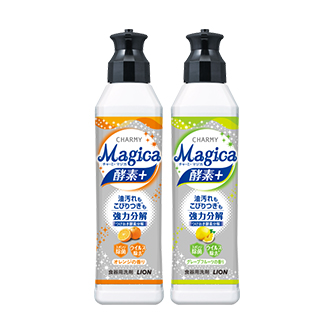
Development of CHARMY Magica Enzyme+ (“Plus”), a dishwashing detergent that uses a proprietary blend of enzymes to break down stubborn oily grime
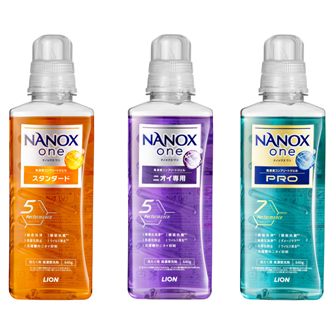
Development of Cleaning Technologies (Detergency, Deodorizing Power, Protection from Yellowing) for NANOX one
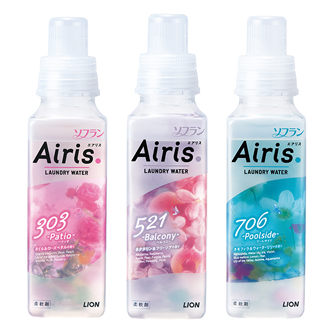
SOFLAN Airis Fabric Softener, Providing a Smooth, Non-Clingy Feel When Wet, Such As After Sweating
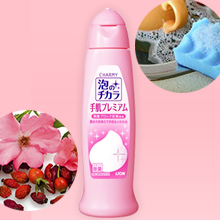
Dishwashing Detergent Developed with a Focus on Skin Moisture:CHARMY Awa no Chikara (Power of Suds) Hand Premium

Heyaboshi (Hang-to-Dry Indoors) TOP—Prevents Odors Even During Laundry Use
Related Information